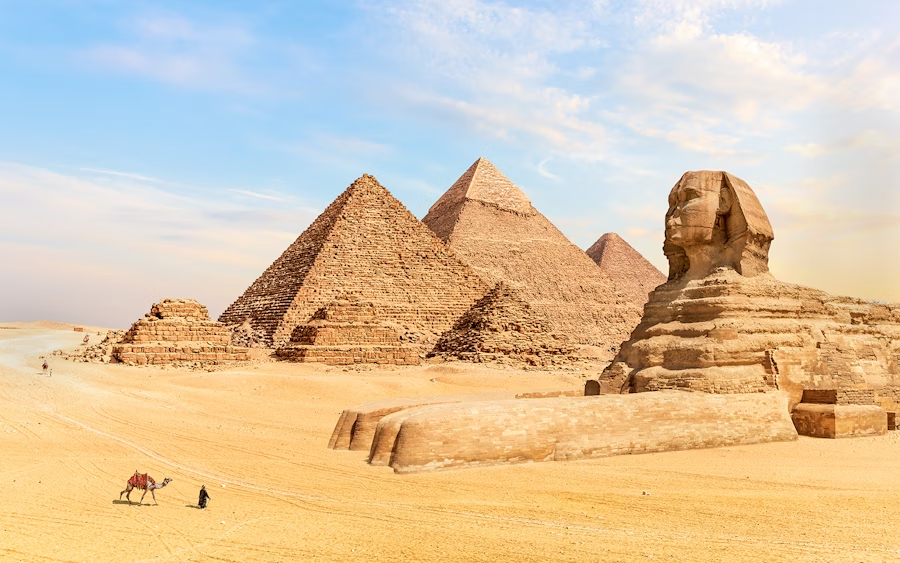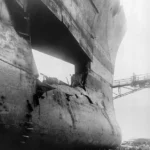Ancient civilizations left behind extraordinary monuments that continue to captivate minds and challenge our understanding of early engineering capabilities. These remarkable structures, from the Great Pyramid of Giza to the Hanging Gardens of Babylon, showcased advanced mathematical principles, innovative construction techniques, and precise astronomical alignments that modern engineers still study today.
The seven ancient wonders represented the pinnacle of human achievement in their time, demonstrating mastery over materials, logistics, and architectural design. Each structure required thousands of workers, years of planning, and solutions to complex engineering problems without modern tools or technology.
These monuments served as testaments to human ingenuity and ambition, while also fulfilling practical, religious, and cultural purposes for their societies. Their influence extends beyond their original functions, inspiring countless generations of architects and engineers to push the boundaries of what’s possible in construction.
Historical Context of Ancient Engineering
Ancient civilizations developed remarkable engineering capabilities through systematic observation, mathematical understanding, and practical experimentation. Their achievements laid the groundwork for modern construction and engineering principles.
Civilizations of Antiquity
The Egyptians established sophisticated engineering practices as early as 3000 BCE, creating precise architectural alignments and complex irrigation systems along the Nile River.
Mesopotamian societies in the Fertile Crescent pioneered urban planning and water management through innovative canal networks and flood control structures between 4000-2000 BCE.
The Greeks contributed significant mathematical principles to engineering between 800-300 BCE, with figures like Archimedes developing fundamental concepts in mechanics and mathematics.
Roman engineers revolutionized construction techniques from 500 BCE to 500 CE, introducing concrete, the arch, and standardized building practices across their vast empire.
Technological Advances of the Period
Ancient engineers developed pulleys, levers, and inclined planes to move massive stone blocks weighing up to 70 tons. These simple machines formed the basis of complex construction projects.
Metal tools evolved from copper to bronze and iron, enabling more precise cutting and shaping of building materials. This technological progression dramatically improved construction capabilities.
Surveying instruments like the groma and dioptra allowed ancient builders to achieve remarkable precision in architectural layouts and structural alignments.
Role of Engineering in Ancient Societies
Engineering projects served as symbols of political power and religious devotion. Rulers commissioned massive monuments and public works to demonstrate their authority.
Ancient engineers held prestigious positions in their societies. Egyptian architects like Imhotep achieved near-divine status for their contributions to monumental architecture.
Engineering knowledge was carefully guarded and passed down through specialized guilds and apprenticeship systems. This created distinct traditions of expertise in different regions.
Public works engineering improved daily life through aqueducts, roads, and harbors. These infrastructure projects facilitated trade and urban development across ancient empires.
The Great Pyramid of Giza
The Great Pyramid of Giza stands as the oldest and largest of Egypt’s pyramids, built around 2560 BCE during the reign of Pharaoh Khufu. At 481 feet tall, it remained the world’s tallest man-made structure for over 3,800 years.
Construction Techniques and Materials
The pyramid consists of approximately 2.3 million limestone blocks, each weighing between 2.5 to 15 tons. Workers transported these blocks from nearby quarries using wooden sleds and ramps.
Teams of skilled craftsmen cut the stones with copper chisels and bronze saws, achieving joints so precise that modern tools can’t fit a credit card between them.
The outer casing originally featured polished white limestone that made the pyramid shine like a jewel in the desert sun. Most of this casing was removed in medieval times for other construction projects.
Recent research suggests that workers used internal ramps to move stones up the pyramid during construction, rather than the previously theorized external ramps.
Mathematical Precision and Alignment
The pyramid’s base is level to within 2.1 centimeters, with sides oriented to the cardinal directions with remarkable accuracy.
The structure embodies the mathematical constant pi (π), as the ratio of its perimeter to height multiplied by 2 gives pi accurate to several decimal places.
Each side of the base measures 230.4 meters, with angles of nearly perfect 90-degree corners. The sides rise at an angle of 51 degrees and 51 minutes.
Cultural and Religious Significance
The pyramid served as Pharaoh Khufu’s tomb and his gateway to the afterlife, containing chambers and passages designed for his spiritual journey.
The King’s Chamber houses a granite sarcophagus and features unique “air shafts” aligned with specific stars, connecting the pharaoh’s spirit to the celestial realm.
Ancient Egyptians believed pyramids represented the primordial mound from which life arose. The smooth sides symbolized the sun’s rays, helping the king’s soul ascend to join the gods.
The pyramid complex included temples, smaller pyramids for queens, and a causeway connecting to the Nile, forming a complete spiritual and administrative center.
Hanging Gardens of Babylon
The Hanging Gardens of Babylon represent one of the most enigmatic and architecturally innovative structures of the ancient world, combining advanced irrigation systems with elaborate terraced gardens that rose approximately 75 feet into the air.
Legendary Descriptions and Archaeological Evidence
Ancient Greek historians described the gardens as a series of ascending terraces supported by stone columns. The structure reportedly measured 400 feet by 400 feet at its base and contained exotic plants from across the empire.
King Nebuchadnezzar II allegedly built the gardens around 600 BCE as a gift to his wife Amytis, who missed the green mountains of her homeland in Media.
Recent archaeological studies suggest the gardens might have been located in Nineveh rather than Babylon, with evidence pointing to King Sennacherib as the possible builder.
Irrigation Methods and Botanical Considerations
The gardens employed an advanced chain pump system that drew water from the Euphrates River to irrigate plants at various heights.
Engineers designed a sophisticated waterproofing system using layers of reed, tar, and lead to prevent water damage to the structure’s foundation.
The terraces supported a diverse range of plants, including trees, shrubs, and vines. Scientists estimate the gardens required approximately 8,200 gallons of water daily to maintain.
Workers likely planted species suited to the hot Mesopotamian climate, including date palms, pomegranates, and cypresses, alongside imported vegetation from cooler regions.
Statue of Zeus at Olympia
The 40-foot-tall Statue of Zeus, completed around 435 BCE, represented the supreme Greek god seated on an ornate throne inside the Temple of Zeus at Olympia. The masterpiece utilized gold and ivory on a wooden frame to create one of the most magnificent sculptures of the ancient world.
Artistic Contributions of Phidias
Phidias, Athens’ most celebrated sculptor, directed the creation of this colossal work during the height of Classical Greek art. His workshop, discovered by archaeologists near the temple site, contained tools and ivory chips that confirmed the statue’s construction location.
The statue depicted Zeus holding Nike (Victory) in his right hand and a scepter with an eagle in his left. The god’s robe and ornaments featured intricate designs of lilies, animals, and mythological scenes.
Zeus’s throne incorporated gold, precious stones, ebony, and ivory, with painted figures and relief carvings depicting Greek myths and heroes.
Techniques in Chryselephantine Sculpture
The chryselephantine technique combined thin sheets of gold and ivory panels attached to a wooden framework. Craftsmen shaped heated ivory plates to create the god’s flesh tones, while gold formed his robes and accessories.
The statue required constant maintenance. Workers applied olive oil to the ivory to prevent cracking in Olympia’s humid conditions. A shallow pool of water in front of the statue helped maintain appropriate moisture levels.
Specialized artisans developed innovative joining methods to connect the ivory plates seamlessly. They used a combination of dowels, pins, and adhesives to secure the precious materials to the wooden core.
Temple of Artemis at Ephesus
The Temple of Artemis at Ephesus stood as one of the largest and most magnificent Greek temples ever built, earning its place among the Seven Wonders of the Ancient World. Built and rebuilt three times, its final version emerged around 550 BCE under the patronage of Croesus of Lydia.
Architectural Features and Innovations
The temple measured 377 feet long and 180 feet wide, featuring 127 columns that soared 60 feet high. Each marble column was carved with intricate relief sculptures at the base.
The innovative design incorporated a raised platform called the crepidoma, accessed by 13 steps. This elevation protected the temple from flooding while creating an imposing appearance.
Architects used revolutionary techniques to strengthen the foundation, laying charcoal and wool beneath the marble to absorb moisture and protect against earthquakes.
The temple’s most striking feature was its marble roof, the first of its kind in Greek architecture. This engineering achievement required precise calculations and cutting-edge construction methods.
Cultural Impact and Economic Importance
The Temple served as both a religious sanctuary and a major economic center. Merchants, travelers, and pilgrims from across the Mediterranean brought valuable offerings and conducted trade.
The site functioned as an ancient bank, where kings and merchants stored their wealth under Artemis’s divine protection. This banking activity helped establish Ephesus as a crucial commercial hub.
Artisans created countless statues, jewelry, and ceremonial objects for sale to visitors, developing a thriving local economy centered around the temple’s activities.
The temple’s destruction by arson in 356 BCE coincided with Alexander the Great’s birth, leading to numerous legends and cultural connections that persist in historical accounts.
Mausoleum at Halicarnassus
Built around 350 BCE in modern-day Bodrum, Turkey, the Mausoleum at Halicarnassus stood 148 feet tall as the tomb of Carian ruler Mausolus, combining Persian, Greek, and Egyptian architectural elements to create one of the most impressive monuments of the ancient world.
Tomb Construction and Physical Structure
The Mausoleum featured a rectangular base adorned with relief sculptures depicting battles and Greek mythology. Its stepped pyramid roof was crowned with a quadriga – a four-horse chariot sculpture.
The structure incorporated 36 columns in its design, creating a temple-like appearance on the middle level. Four master sculptors – Leochares, Bryaxis, Scopas, and Timotheus – each decorated one side of the building.
The monument’s main chamber housed the tombs of Mausolus and his sister-wife Artemisia II. Marble blocks weighing up to 2.5 tons were precisely cut and fitted together without mortar.
The Mausoleum survived intact for nearly 1900 years until a series of earthquakes damaged it between the 12th and 15th centuries CE.
Influences on Later Sepulchral Architecture
The term “mausoleum” derives directly from Mausolus’s tomb, becoming the standard word for grand tomb structures throughout history.
The Mausoleum’s design influenced numerous notable buildings, including Grant’s Tomb in New York and the Indiana War Memorial in Indianapolis.
Renaissance architects studied the Mausoleum’s reported dimensions and descriptions to incorporate its elements into their own designs. The stepped pyramid style became particularly popular in funerary architecture.
The building’s fusion of different architectural traditions created a new standard for monumental tombs, inspiring similar structures across the Roman Empire and beyond.
Colossus of Rhodes
The Colossus of Rhodes stood as a magnificent bronze statue of the Greek god Helios, reaching approximately 108 feet tall at the harbor entrance of Rhodes. Built between 292 and 280 BCE, this massive structure represented one of the most ambitious sculptural projects of the ancient world.
Engineering Challenges and Solutions
The ancient Greek engineers developed innovative techniques to construct the massive bronze statue. They created an iron framework as the core structure, then attached shaped bronze plates to form the exterior.
Workers built the statue in sections, starting from the feet and moving upward. They used an earthen ramp that grew alongside the statue, allowing them to transport materials to higher levels.
The statue’s base incorporated a sophisticated system of iron beams and stone blocks to distribute its enormous weight effectively. Engineers angled the legs slightly inward for increased stability against winds and earthquakes.
The bronze plates were carefully hammered and fitted together using a complex system of brackets and supports. This technique allowed for thermal expansion while maintaining structural integrity.
The statue stood for approximately 54 years before an earthquake in 226 BCE caused it to break at the knees and collapse. The engineering methods used in its construction influenced future large-scale sculptures and monuments.
Lighthouse of Alexandria (Pharos)
The Lighthouse of Alexandria stood as one of the most remarkable engineering achievements of the ancient world, rising approximately 330 feet tall on Pharos Island. Built between 280 and 247 BCE under Ptolemy I and II, this marble and limestone beacon guided ships safely to Alexandria’s harbor for centuries.
Design Features and Optical Enhancements
The lighthouse consisted of three distinct sections: a square base, an octagonal middle, and a cylindrical top. The base housed storage rooms and living quarters for workers.
A spiral ramp allowed donkeys to carry fuel to the beacon chamber at the summit. The structure incorporated over 300 rooms within its walls.
The beacon utilized an innovative system of mirrors and lenses to amplify its light. Bronze mirrors reflected sunlight during day, while a massive fire burned at night.
Historians estimate the light could be seen from up to 30 miles away, making it the brightest artificial light source of its time.
Role in Ancient Navigation
The Pharos lighthouse served as the primary navigational aid for Mediterranean ships approaching Egypt’s most important port city.
Ships relied on its distinct light pattern to avoid the dangerous reefs and sandbanks near Alexandria’s harbor entrance.
The lighthouse symbolized Alexandria’s status as a center of commerce and learning. Its image appeared on ancient coins and inspired similar structures across the Roman Empire.
Maritime records indicate the lighthouse remained operational until damaged by earthquakes in the 14th century CE. Its remains were used to build the Citadel of Qaitbay in 1480.
References
- National Geographic (n.d.) – The Seven Wonders of the Ancient World: Engineering Marvels of Early Civilizations Link
- Smithsonian Magazine (n.d.) – How the Great Pyramid of Giza Was Built: Theories and Archaeological Discoveries Link
- History.com (n.d.) – The Hanging Gardens of Babylon: Myth or Reality? Link
- BBC History (n.d.) – The Statue of Zeus and the Artistic Legacy of Ancient Greece Link
- Ancient.eu (n.d.) – The Mausoleum at Halicarnassus: The Origin of Grand Tomb Architecture Link
- NASA (n.d.) – Ancient Navigation and the Lighthouse of Alexandria Link
- Archaeology Magazine (n.d.) – Colossus of Rhodes: Engineering the Giant Bronze Statue of Helios Link




